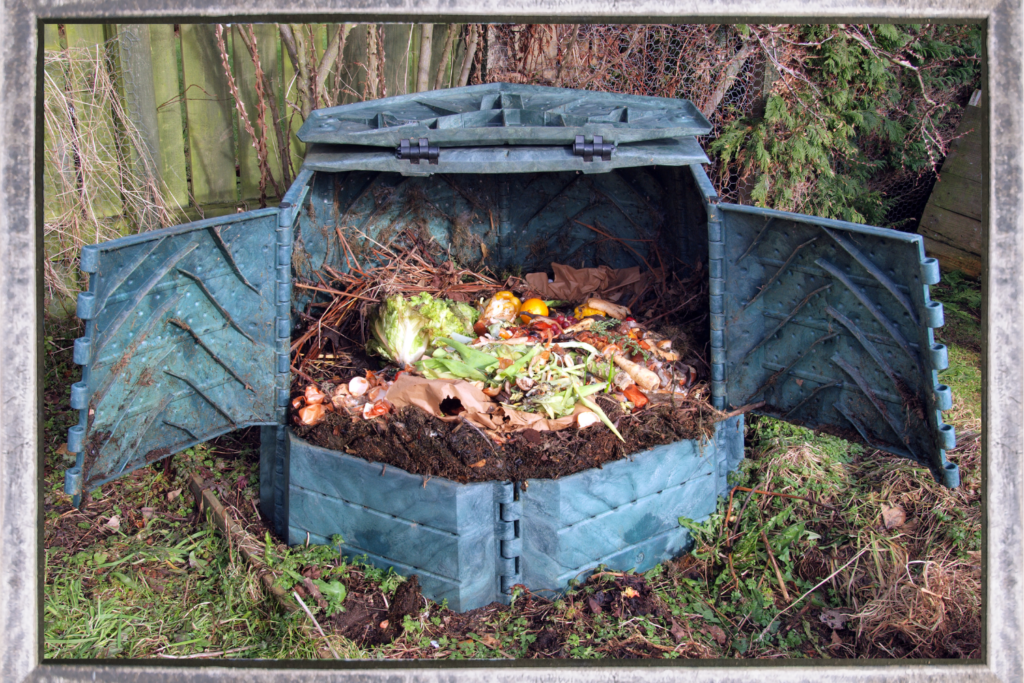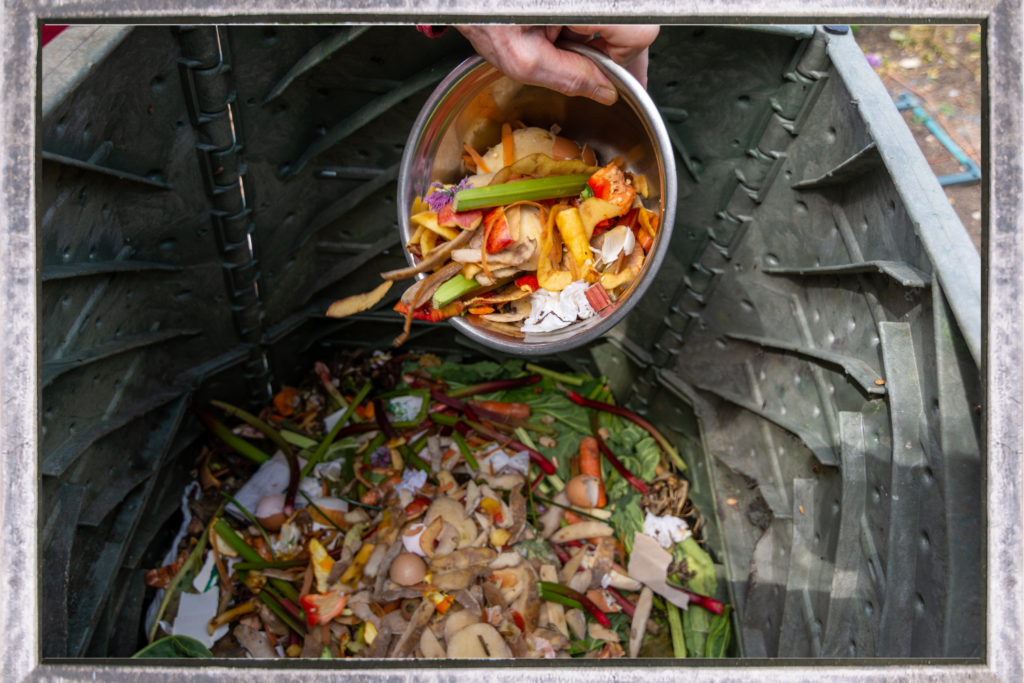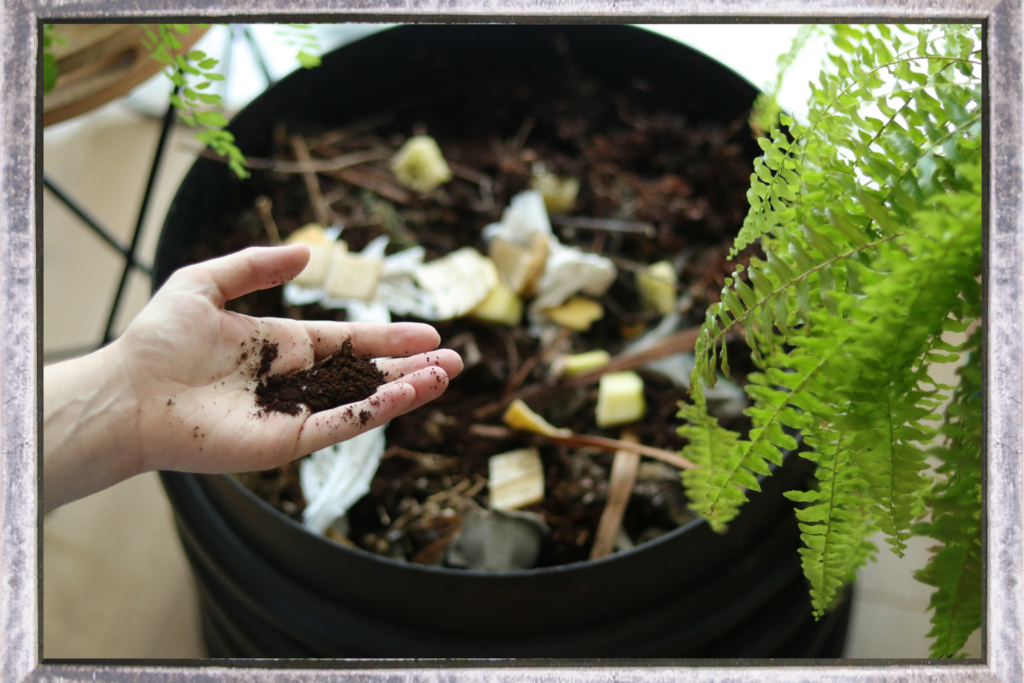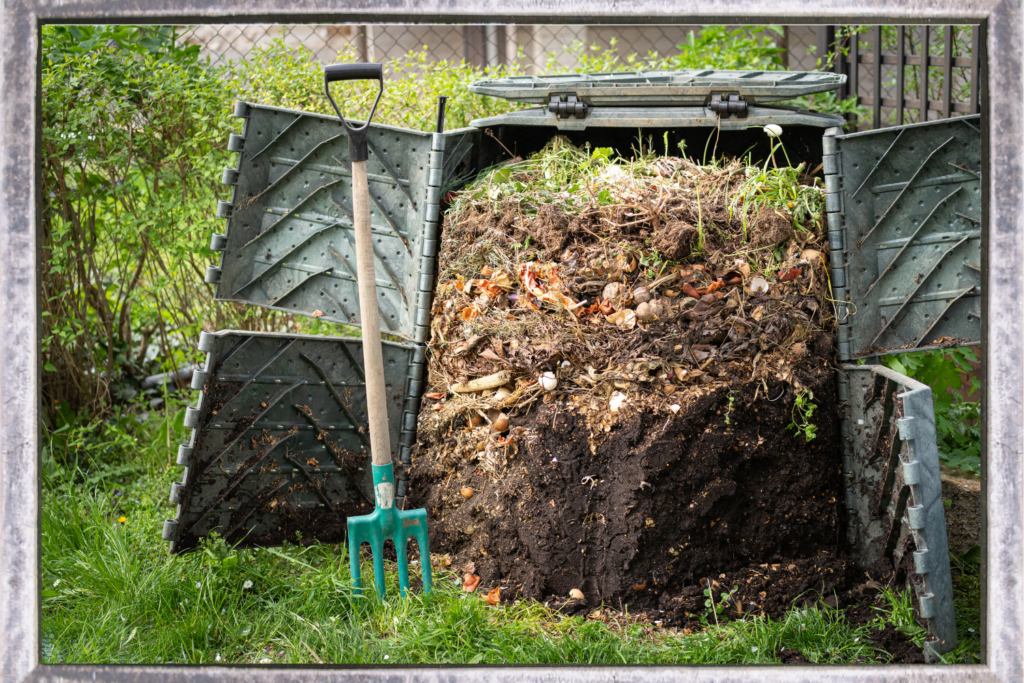
Composting is a transformative process that turns organic waste into nutrient-rich soil, benefiting both the environment and our gardens. Whether you’re an eco-conscious homeowner or a seasoned gardener, composting is a sustainable practice that reduces waste and enhances soil health. In this comprehensive guide, we’ll delve into the intricacies of composting, from setting up your compost system to maintaining it effectively. We’ll explore the benefits of ready-made compost bins versus DIY setups, and we’ll hear from experts on the scientific principles and environmental advantages of composting.
This post may contain affiliate links. As an Amazon affiliate, we earn from qualifying purchases. But we only recommend products we would use ourselves. View our Disclosure Policy here.
Chapter 1: Understanding Composting
Composting is the natural decomposition of organic materials into a nutrient-rich soil amendment known as compost. This process occurs through the action of microorganisms, such as bacteria and fungi, breaking down organic matter like kitchen scraps, yard waste, and paper products. The key components for successful composting include:
Carbon-rich “browns”: Carbon-rich materials provide energy for microorganisms and help maintain the structure of the compost pile. Examples of browns include dried leaves, straw, shredded cardboard, newspaper, and sawdust. These materials are typically dry and bulky, serving as the “brown” layer in the composting process. They provide carbon for microorganisms to consume as they break down organic matter.
Nitrogen-rich “greens”: Nitrogen-rich materials provide protein and other essential nutrients for microorganisms, accelerating the decomposition process. Examples of greens include fruit and vegetable scraps, coffee grounds, grass clippings, and garden trimmings. These materials are typically moist and rich in nitrogen, serving as the “green” layer in the composting process. They provide the necessary nutrients to support microbial activity and promote rapid decomposition.
Water: Adequate moisture is essential for composting, as it helps microorganisms thrive and facilitates the breakdown of organic matter. The ideal moisture content for a compost pile is similar to that of a wrung-out sponge: moist but not waterlogged. Lack of moisture can slow down the composting process, while excess moisture can lead to anaerobic conditions and unpleasant odors. It’s essential to monitor moisture levels regularly and adjust as needed by adding water or browns to balance the moisture content.
Oxygen: Oxygen is crucial for aerobic composting, where microorganisms break down organic matter in the presence of oxygen. Turning or aerating the compost pile regularly helps introduce oxygen and promote microbial activity. This can be done using a pitchfork, compost aerator, or by tumbling the contents of a compost bin. Adequate airflow is also essential for preventing anaerobic conditions, which can result in foul odors and slow decomposition. Ensuring proper aeration of the compost pile is key to maintaining optimal conditions for microbial activity and efficient composting.

Understanding the role of these key components and maintaining the right balance is fundamental to successful composting. By providing a mix of carbon-rich browns, nitrogen-rich greens, adequate moisture, and oxygen, you can create an ideal environment for microorganisms to thrive and transform organic waste into valuable compost.
Chapter 2: Setting Up Your Compost System
Before diving into composting, it’s essential to choose the right composting system for your needs. There are various options available, each with its advantages and considerations:
Ready-made compost bins: Most commercial compost bins come in a range of sizes, shapes, and designs, catering to different preferences and space constraints. Ready-made bins offer convenience and may include features like tumbling mechanisms for easier turning, ventilation systems for airflow, and pest-proof designs. They are typically made from durable materials such as plastic, wood, or metal and are designed to withstand outdoor conditions. Ready-made bins are ideal for beginners or those who prefer a hassle-free composting experience. They require minimal assembly and maintenance, making them a convenient option for urban and suburban settings.
DIY compost bins: Building your compost bin allows for customization and can be a cost-effective option, especially if you have access to recycled materials. Common DIY options include wooden pallet bins, wire mesh bins, or even simple heap composting. Wooden pallet bins are relatively easy to construct and provide ample space for composting large quantities of organic waste. Wire mesh bins offer excellent airflow and are suitable for backyard composting. Heap composting involves simply creating a pile of organic materials directly on the ground, which can be covered with a tarp or left open to the elements. DIY compost bins allow for flexibility in size, design, and location, allowing you to tailor your composting system to fit your specific needs and preferences.
Regardless of the system you choose, there are several factors to consider when setting up your compost system:
Location: Choose a convenient location for your compost bin that receives adequate sunlight and is easily accessible for adding materials and turning the pile. Avoid placing the compost bin directly against structures or near trees, as roots may interfere with the composting process.
Drainage: Ensure your compost bin has proper drainage to prevent waterlogging, which can lead to anaerobic conditions and unpleasant odors. Elevating the bin slightly off the ground or adding drainage holes to the bottom can help excess moisture drain away.
Airflow: Good airflow is essential for aerobic composting, where microorganisms break down organic matter in the presence of oxygen. Choose a compost bin design that allows for adequate airflow, whether through ventilation holes, slatted sides, or open-bottom designs.
Size: Consider the amount of organic waste you generate and choose a compost bin size that can accommodate your needs. A larger compost bin will compost materials more efficiently and produce compost more quickly, but it may also require more space and maintenance.
By carefully considering these factors and choosing the right composting system for your needs, you can set yourself up for success and enjoy the many benefits of composting. Whether you opt for a ready-made bin or decide to build your own, composting is a rewarding and sustainable practice that can help reduce waste, improve soil health, and support a healthier environment.

Chapter 3: Composting Process from Start to Finish
Now that your compost system is in place, let’s delve into the composting process step by step:
Layering: Layering your compost materials is the first step in creating a balanced compost pile. Alternating between carbon-rich “browns” and nitrogen-rich “greens” helps achieve the right carbon-to-nitrogen ratio, which is essential for efficient decomposition. Aim for roughly equal parts of browns and greens by volume. Start with a layer of browns, such as shredded newspaper or dried leaves, followed by a layer of greens, such as fruit and vegetable scraps or grass clippings. Continue layering browns and greens until you reach a height of around three feet, ensuring each layer is evenly distributed and adequately moistened.
Turning: Regular turning or aerating of your compost pile is crucial for introducing oxygen and promoting aerobic decomposition. Oxygen fuels the activity of aerobic microorganisms, which break down organic matter more efficiently than their anaerobic counterparts. Turning the compost pile also helps mix the materials, ensuring even decomposition and preventing the formation of anaerobic pockets. Aim to turn your compost pile every one to two weeks using a pitchfork, compost aerator, or by tumbling the contents of a compost bin. This helps maintain optimal conditions for microbial activity and accelerates the composting process.
Moisture Management: Proper moisture management is essential for successful composting. The ideal moisture content for a compost pile is similar to that of a wrung-out sponge: moist but not waterlogged. Lack of moisture can slow down decomposition, while excess moisture can lead to anaerobic conditions and foul odors. Monitor the moisture level of your compost pile regularly and adjust as needed by adding water or browns to balance the moisture content. During hot and dry weather, you may need to water your compost pile more frequently to prevent it from drying out.
Temperature Monitoring: Monitoring the temperature of your compost pile is an essential aspect of composting. As microorganisms break down organic matter, they generate heat as a byproduct of their metabolic activity. The internal temperature of a compost pile can reach between 120°F and 160°F during active decomposition, which is ideal for accelerating the composting process and killing weed seeds and pathogens. Use a compost thermometer to monitor the temperature of your compost pile regularly, inserting it into the center of the pile to obtain an accurate reading. If the temperature of your compost pile drops below 100°F, it may indicate that microbial activity has slowed, and you may need to adjust the moisture level or add more greens to reinvigorate decomposition.
By following these steps and incorporating best practices for composting, you can create a healthy and productive compost pile that transforms organic waste into nutrient-rich compost for your garden. With proper layering, turning, moisture management, and temperature monitoring, you’ll be well on your way to producing high-quality compost that enriches your soil and supports plant growth.
Chapter 4: Tips and Tricks for Successful Composting
Here are some additional tips and tricks to optimize your composting experience:
Particle Size: Breaking down organic materials into smaller particle sizes can accelerate the composting process by increasing the surface area available for microbial activity. Consider chopping or shredding large materials such as branches, stalks, and cardboard before adding them to your compost pile. This allows microorganisms to access the materials more efficiently, leading to faster decomposition.
Temperature Regulation: While a compost pile’s internal temperature naturally rises during active decomposition, excessively high temperatures can be detrimental to beneficial microorganisms. If your compost pile becomes too hot, it may indicate that microbial activity is out of control, leading to the loss of valuable nutrients and beneficial organisms. To regulate temperature, consider adding larger amounts of browns or turning the pile more frequently to introduce oxygen and cool down the composting process.
Vermicomposting: Vermicomposting, or composting with worms, is an alternative method that can accelerate decomposition and produce high-quality compost. Red worms (Eisenia fetida) and other composting worms feed on organic matter and produce nutrient-rich castings, known as vermicompost. To vermicompost, introduce worms into a separate bin or pile containing moistened bedding materials such as shredded newspaper or coconut coir, along with kitchen scraps and other organic waste. The worms will process the materials, converting them into nutrient-rich vermicompost that can be used to fertilize plants.

4. Compost Tea: Compost tea is a liquid fertilizer made from steeping compost in water and extracting nutrients through aeration. To make compost tea, place a handful of finished compost in a permeable bag or container and steep it in water for 24 to 48 hours, stirring occasionally to aerate the mixture. The resulting liquid can be diluted with water and applied to plants as a foliar spray or soil drench, providing a boost of nutrients and beneficial microorganisms. Compost tea can help improve soil fertility, suppress plant diseases, and enhance plant growth when used as part of a regular fertilization regimen.
5. Composting Pit: In areas where space is limited or aesthetic considerations are a concern, consider composting in a pit or trench. Dig a hole or trench in the ground and fill it with alternating layers of browns and greens, similar to traditional composting methods. Cover the pit with soil or a layer of mulch to prevent odors and discourage pests. Composting pits are discreet and can be an effective way to recycle organic waste while minimizing visual impact.
By incorporating these additional tips and tricks into your composting routine, you can maximize the efficiency and effectiveness of your composting efforts. Whether you’re breaking down materials into smaller particle sizes, regulating temperature, experimenting with vermicomposting, brewing compost tea, or composting in a pit, there are many strategies you can employ to produce high-quality compost for your garden. Experiment with different techniques and find what works best for your specific needs and conditions.
Chapter 5: Benefits of Ready-made Compost Bins versus DIY
When considering whether to invest in a ready-made compost bin or embark on a DIY composting adventure, it’s essential to weigh the pros and cons of each option. Here, we’ll explore the benefits of both approaches:
Ready-made Compost Bins:
- Convenience: Ready-made compost bins are designed for ease of use, often coming fully assembled or requiring minimal setup. This convenience is particularly appealing to those with busy schedules or limited DIY skills.
- Features: Many ready-made compost bins come with features designed to streamline the composting process, such as tumbling mechanisms for easier turning, ventilation systems for improved airflow, and pest-proof designs to deter unwanted visitors.
- Durability: Commercially available compost bins are typically constructed from durable materials such as plastic, wood, or metal, designed to withstand outdoor conditions and last for many years with proper maintenance.
- Aesthetics: Ready-made compost bins often feature sleek designs and attractive finishes, making them a visually appealing addition to any garden or outdoor space.
DIY Compost Bins:
- Customization: Building your compost bin allows for customization to fit your specific space requirements, composting goals, and aesthetic preferences. You can choose the size, shape, and materials that best suit your needs, whether it’s repurposing wooden pallets, constructing a wire mesh bin, or building a custom-designed structure.
- Cost-effectiveness: DIY compost bins can be more cost-effective than purchasing a ready-made option, especially if you have access to recycled or repurposed materials. Building your compost bin allows you to save money on materials and tailor the design to fit your budget.
- Sustainability: By building your compost bin, you can incorporate sustainable practices such as upcycling materials and reducing waste. Repurposing items like wooden pallets, old barrels, or wire mesh fencing not only reduces landfill waste but also minimizes the environmental impact of manufacturing new products.
- Learning Experience: Embarking on a DIY composting project provides an opportunity to learn new skills, experiment with design concepts, and gain a deeper understanding of the composting process. Whether you’re honing your carpentry skills or exploring creative reuse options, building your compost bin can be a rewarding and educational experience.
Ultimately, the decision between ready-made compost bins and DIY options depends on your individual preferences, priorities, and resources. If convenience, durability, and aesthetics are paramount, a ready-made compost bin may be the best choice. However, if you value customization, cost-effectiveness, sustainability, and the opportunity to learn and experiment, building your compost bin could be the perfect solution. Regardless of the path you choose, composting is a valuable practice that benefits both the environment and your garden, so dive in and start composting today!

Chapter 6: Scientific Insights and Environmental Benefits
Composting isn’t just a beneficial practice for gardeners; it also holds significant advantages for the environment. Let’s delve deeper into the scientific principles and environmental benefits of composting, as elucidated by experts in the field:
Dr. Sarah Miller, a soil scientist at the University of Agriculture, shares her insights on the environmental benefits of composting:
Reduction of Methane Emissions: Organic waste sent to landfills undergoes anaerobic decomposition, releasing methane, a potent greenhouse gas with a significantly higher warming potential than carbon dioxide. By diverting organic waste from landfills and composting it instead, we can significantly reduce methane emissions and mitigate climate change. Composting creates aerobic conditions that promote the breakdown of organic matter into stable, carbon-rich compost, thereby minimizing methane production.
Soil Health and Fertility: Compost is a valuable soil amendment that improves soil structure, fertility, and water retention. The organic matter in compost provides essential nutrients for plant growth, enhances soil aggregation, and increases microbial activity. As compost decomposes, it releases nutrients such as nitrogen, phosphorus, and potassium in a slow-release form, promoting healthy plant growth and reducing the need for chemical fertilizers. Additionally, compost improves soil water-holding capacity, reducing water runoff and erosion, particularly in sandy or compacted soils.
Biodiversity and Ecosystem Resilience: Compost fosters biodiversity in soil ecosystems, supporting a diverse community of microorganisms, earthworms, insects, and other soil organisms. These soil organisms play crucial roles in nutrient cycling, soil aeration, and pest control, contributing to ecosystem resilience and productivity. By enhancing soil biodiversity through composting, we can create healthier, more resilient ecosystems that are better equipped to withstand environmental stressors such as drought, disease, and climate change.
Waste Reduction and Resource Conservation: Composting diverts organic waste from landfills, reducing the burden on waste management infrastructure and conserving valuable resources. By composting food scraps, yard waste, and other organic materials, we can return nutrients to the soil in a closed-loop system, minimizing the need for synthetic fertilizers and reducing the environmental footprint of food production. Composting also extends the lifespan of landfills, conserving landfill space and mitigating environmental pollution associated with landfill leachate and greenhouse gas emissions.
Composting is a powerful tool for mitigating climate change, enhancing soil health, promoting biodiversity, and conserving resources. By harnessing the scientific principles of composting and embracing its environmental benefits, we can contribute to a more sustainable and resilient future for generations to come. As Dr. Miller emphasizes, “Composting is not just a gardening practice; it’s a fundamental component of sustainable living that benefits both people and the planet.”
Other articles you may find interesting. We hope you enjoy our tips, tricks, and ideas.
